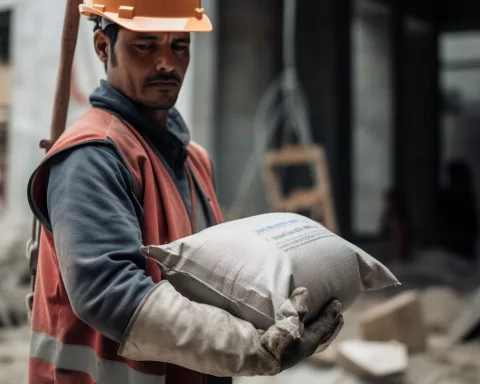The importance of safety adherence in the construction industry has been emphasized following recent building disasters in South Africa. The Department of Employment and Labour is committed to conducting detailed examinations and introducing necessary precautions to safeguard workers. The Ballito building disaster that took four lives has left a lasting impact on the community, and investigations have established a connection between the contractor managing the construction work and the owner of the private house. The government urges all employers to understand and adhere to health and safety laws to avoid the repetition of such tragic incidents.
Safety Measures in the Construction Sector
Following recent building disasters in South Africa, the importance of safety adherence in the construction industry is being emphasized. The Department of Employment and Labour is committed to conducting detailed examinations and introducing necessary precautions to safeguard workers, including following the Occupational Health and Safety Act. Section 31 of this act empowers an inspector to investigate incidents and determine if a formal inquiry is needed to prevent such incidents from occurring again.
The Town of Ballito: A Scenic Locale with a Tragic Tale
Situated in the core of South Africa along the magnificent Dolphin Coast, the bustling town of Ballito is renowned for its pleasant weather and welcoming beaches. This tourist hotspot and local favourite has lately gained attention for a rather grim reason – a heartbreaking building disaster that took four lives and left a lasting impact on the community.
A warm welcome to all readers. The government expresses its profound sympathy to the loved ones and acquaintances of those who perished in the Ballito occurrence. It is a mournful period, made even more touching following the George building disaster in the Western Cape that took 34 lives. These devastating events emphasize the constant requirement for safety adherence in the construction industry.
Safety Measures in the Construction Sector
Following these calamities, the Department of Employment and Labour has committed to conducting detailed examinations and introducing necessary precautions to safeguard workers. The critical role of safety in construction and the obligation to stringently follow the Occupational Health and Safety Act is being emphasised.
The South African Police Service (SAPS) currently has active jurisdiction over the site, and the Department can only engage Section 31 for an examination after the official handover. The Occupational Health and Safety Act, an essential piece of legislation, requires secure working conditions and correct use of machinery and equipment. This Act safeguards not only the workers but also everyone impacted by the operations.
Section 31 of this act empowers an inspector to delve into the specifics of any incident that took place at a workplace or involved the use of machinery or equipment. The aim? To determine if a formal inquiry is warranted. Following this dreadful event, the Department will conduct exhaustive investigations to uncover any potential violations of the Act and prevent such incidents from reoccurring.
The Investigation and Its Findings
Initial findings have established a connection between the contractor managing the construction work and the owner of the private house where the excavation disaster occurred. Investigations showed that a sandbank collapsed alongside a 5-meter deep excavation, burying five employees, four of whom tragically lost their lives. The sole surviving employee owes his survival to the tireless efforts of the rescue workers.
The contractor, registered with the UIF and the Compensation Fund, is presently under examination. Swift assistance for claiming benefits from both Funds is being arranged for the impacted families or dependents. The Compensation Fund will also help with burial expenses as specified by the COIDA, with officials from both Funds guiding families on the required procedures.
Aftermath and Future Preventive Measures
Regrettably, most of the affected employees were from the Eastern Cape Province. The incident has had widespread repercussions, with inspectors identifying potential violations of the Occupational Health and Safety Act and the Construction Health and Safety Regulations. As a result, activities on the site have been halted until compliant safety measures are put in place.
The government urges all employers to understand and adhere to health and safety laws to avoid the repetition of such tragic incidents. In these trying times, the preservation of human life and safety in workplaces must be prioritized. The government remains committed to justice, safety and extends its support to the grieving families.
Siyabonga. We extend our gratitude.
1. What is the importance of safety adherence in the construction industry?
Following recent building disasters in South Africa, the importance of safety adherence in the construction industry is being emphasized. The Department of Employment and Labour is committed to conducting detailed examinations and introducing necessary precautions to safeguard workers, including following the Occupational Health and Safety Act.
2. What is the Occupational Health and Safety Act, and why is it essential?
The Occupational Health and Safety Act requires secure working conditions and correct use of machinery and equipment in the workplace. This Act safeguards not only the workers but also everyone impacted by the operations. Section 31 of this act empowers an inspector to investigate incidents and determine if a formal inquiry is needed to prevent such incidents from occurring again.
3. What happened in the Ballito building disaster?
A sandbank collapsed alongside a 5-meter deep excavation, burying five employees, four of whom tragically lost their lives. The sole surviving employee owes his survival to the tireless efforts of the rescue workers.
4. Who is responsible for the Ballito building disaster, and what actions are being taken?
Initial findings have established a connection between the contractor managing the construction work and the owner of the private house where the excavation disaster occurred. The contractor, registered with the UIF and the Compensation Fund, is presently under examination. Authorities are arranging swift assistance for claiming benefits from both Funds for the impacted families or dependents.
5. What actions are being taken to prevent similar incidents from happening in the future?
Activities on the site have been halted until compliant safety measures are put in place. The government urges all employers to understand and adhere to health and safety laws to avoid the repetition of such tragic incidents. Inspectors are identifying potential violations of the Occupational Health and Safety Act and the Construction Health and Safety Regulations.
6. What is the government’s stance on the importance of safety in the workplace?
The preservation of human life and safety in workplaces must be prioritized. The government remains committed to justice, safety, and extends its support to the grieving families.










